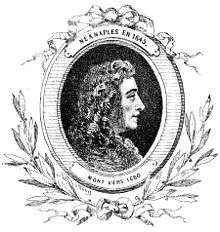Alessandro Stradella

Alessandro Stradella (Nepi, 3 April 1639 [1] – Genoa, 25 February 1682) was an Italian composer of the middle baroque. He enjoyed a dazzling career as a freelance composer, writing on commission, and collaborating with distinguished poets, producing over three hundred works in a variety of genres.[2]
Life
Not much is known about his early life, but he was from a Tuscan aristocratic family, educated at Bologna, and was already making a name for himself as a composer at the age of 20. In 1667 he moved to Rome where he composed for Christina, Queen of Sweden, mostly sacred music. He was involved in performances of four operas, two by Francesco Cavalli and two by Antonio Cesti. Stradella began to live a dissolute life. With Carlo Ambrogio Lonati he attempted to embezzle money from the Roman Catholic Church, but was found out: he fled the city, only returning much later when he thought it was safe. His numerous incautious affairs with women began to make him enemies among the powerful men of the city, and he had to leave Rome for good.
In 1677 he went to Venice, where he was hired by a powerful nobleman, Alvise Contarini, as the music tutor to his mistress, Agnese Van Uffele. She and Stradella began an affair and fled Venice together for Turin, where they were protected by Marie Jeanne Baptiste of Savoy-Nemours, the regent of Savoy.[3] Contarini followed and instructed the Archbishop that Uffelle and Stradella must marry or that Uffelle must take the veil. She did the latter, and then the two married in October; however, as Stradella left the convent after signing the contract, he was attacked from behind on 10 October by two would-be hired assassins, who believed him dead when they left him in the street. He was not. The two assassins took asylum with the French ambassador. That Contarini had hired the attackers became known, leading to complaints from the regent of Savoy to Louis XIV; the matter became a topic of negotiation between the courts. In 1678 Stradella fled to Genoa, where he met again with Lonati. He was paid to compose music for the local nobility and the Teatro Falconi.[2]
In 1682 he was stabbed to death at the Piazza Banchi. His infidelities were well-known, and a nobleman of the Lomellini family hired the killer that put an end to Stradella's life; but the identity of the killer was never discovered.[4] Stradella was buried in the Santa Maria delle Vigne.
Work
Stradella was an extremely influential composer at the time, though his fame was eclipsed in the next century by Corelli, Vivaldi and others. Some of his music was exploited by George Frideric Handel, for example in Israel in Egypt. Probably his greatest significance is in originating the concerto grosso: while Corelli in his Op. 6 was the first to publish works under this title, Stradella clearly uses the format earlier in one of his Sonate di viole. Since the two knew each other, a direct influence is likely.
Stradella wrote at least six baroque operas [5] including a full-length comic opera Il Trespolo tutore. He also wrote more than 170 cantatas, at least one of which was based on a poem by Sebastiano Baldini, and six oratorios. Stradella composed 27 separate instrumental pieces, most for strings and basso continuo, and typically in the sonata da chiesa format.
He wrote two cantatas for the regent of Savoy, Se del pianteta ardenta and Scogliete in dolci nodi.[3]
Legacy
His colorful life and his bloody death ordered by the powerful Lomellini family provided the basis for biographical operas such as Stradella (Paris, 1837) by Louis Niedermeyer and Alessandro Stradella (Hamburg, 1844) by Friedrich von Flotow.
American novelist F. Marion Crawford also produced a highly romanticized novel of Stradella's affair and flight from Venice, titled Stradella (Macmillan 1909).
Recordings
- Stradella: Il barcheggio - Valentina Valente; Marco Lazzara; Giovanni Dagnino; Alessandro Stradella Consort; Estevan Velardi (conductor) Label: Bongiovanni GB 2102
- Stradella: Moro per amore - Marco Beasley; Marco Lazzara; Roberta Invernizzi; Riccardo Ristori; Silvia Piccollo; Alessandro Stradella Consort; Estevan Velardi (conductor). Label: Bongiovanni GB 2153
- Stradella: Esule dalle sfere - Roberta Invernizzi; Marco Lazzara; Riccardo Ristori; Mario Nuvoli; Alessandro Stradella Consort; Estevan Velardi (conductor). Label: Bongiovanni GB 2165
- Cantatas Amanti, olà, olà!; Chi resiste al Dio bendato Estevan Velardi, Alessandro Stradella Consort
- Stradella: Motets Sandrine Piau, Gérard Lesne, Il Seminario musicale
- Cantatas: Brandes, Paul O'Dette, Springfels, Weiss. Harmonia Mundi
- Cantata per il Santissimo Natale (Christmas Eve Cantata): Si apra al riso La Magnifica Comunità. Enrico Casazza. Brilliant
- San Giovanni Battista (1) Erato, (2) Academia Montis Regalis, Alessandro de Marchi. Hyperion 2008
References
- ↑ Gianturco, Carolyn. "Stradella, Alessandro". Grove Music Online. Oxford Music Online. Retrieved July 24, 2011. (subscription required (help)).
- 1 2 Gianturco, Carolyn. "Alessandro Stradella (1639-1682)". Hyperion Records. Retrieved July 24, 2014.
- 1 2 Oresko 2004, p. 24.
- ↑ The story of a love-affair with a pupil was written down by Pierre Bourdelot and published in 1715.
- ↑ Le gare dell'amor eroico ossia l'Oratio Opera in three acts. Genova, Teatro Falcone 1679; revived Genova 2006.
- Oresko, Robert (2004). "Maria Giovanna Battista of Savoy-Nemours (1644-1724): daughter, consort, and Regent of Savoy". In Campbell Orr, Clarissa. Queenship in Europe 1660-1815: The Role of the Consort. Cambridge University Press. pp. 16–55. ISBN 0-521-81422-7.
Further reading
- "Alessandro Stradella", in The New Grove Dictionary of Music and Musicians, Stanley Sadie (ed), 20 vols., London: Macmillan Publishers Ltd., 1980, ISBN 1-56159-174-2
External links
- Free scores by Alessandro Stradella at the International Music Score Library Project
- Free scores by Alessandro Stradella in the Choral Public Domain Library (ChoralWiki)
- Free PDFs of Stradella works in Biblioteca Estense